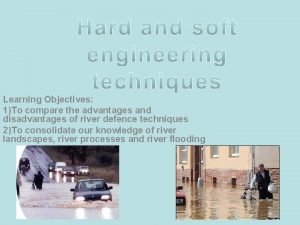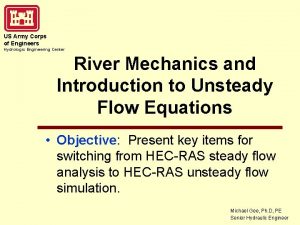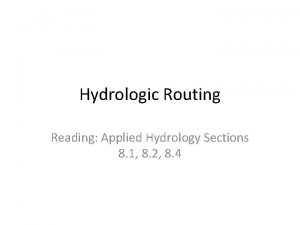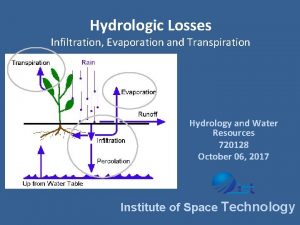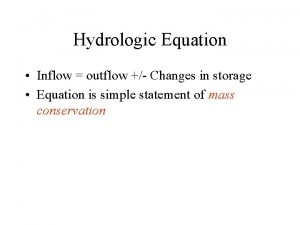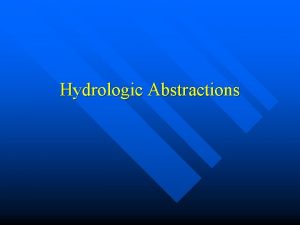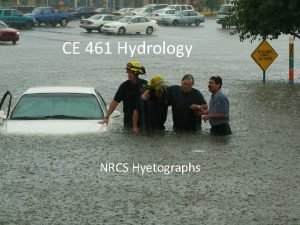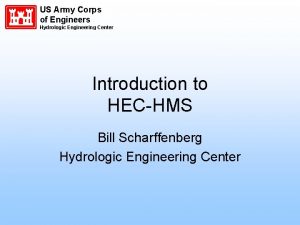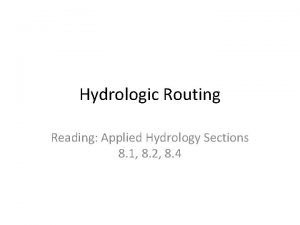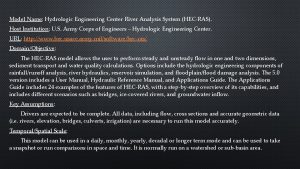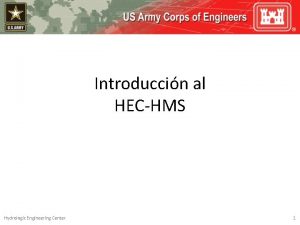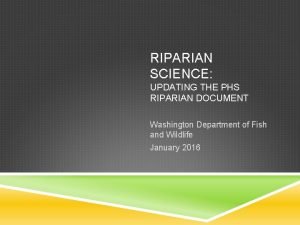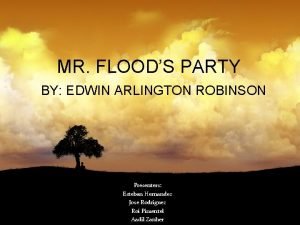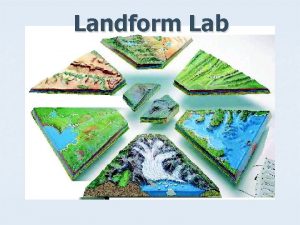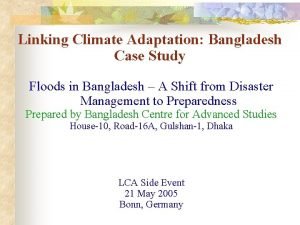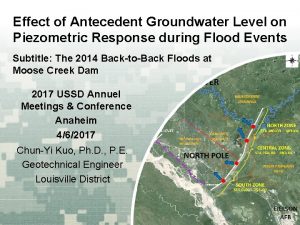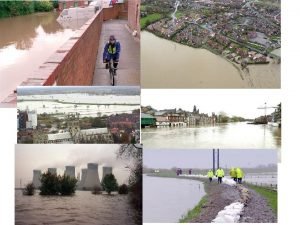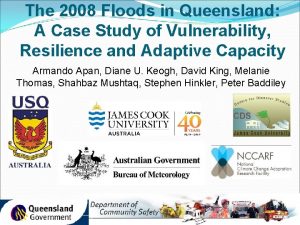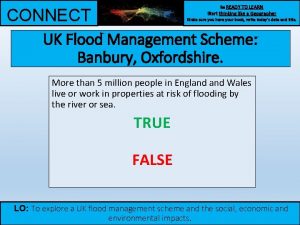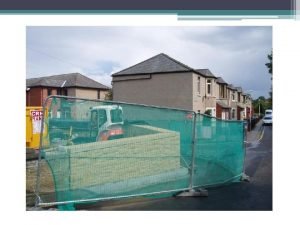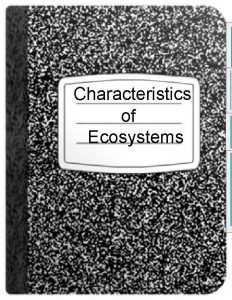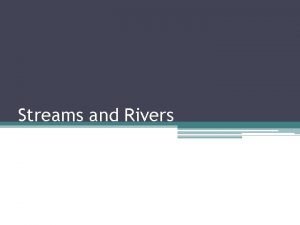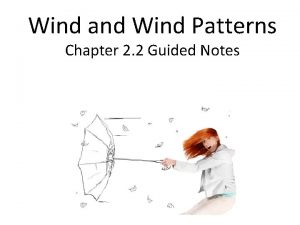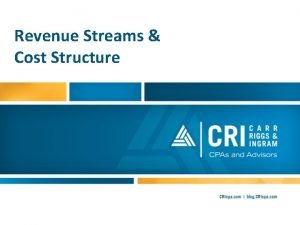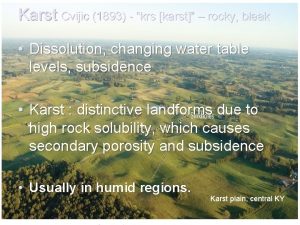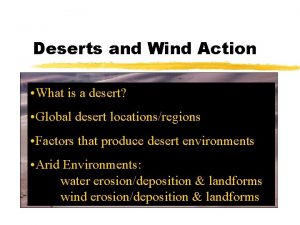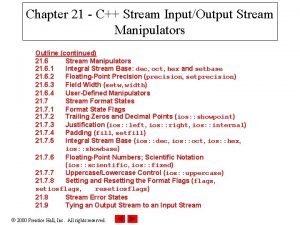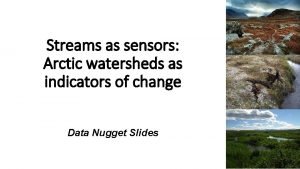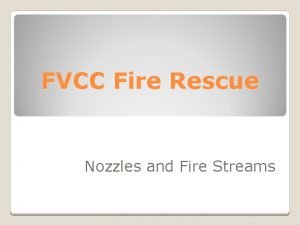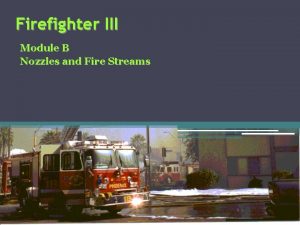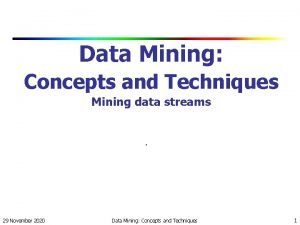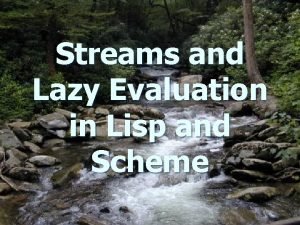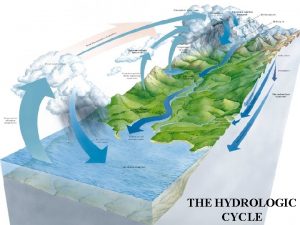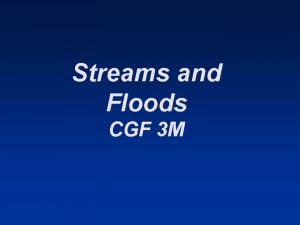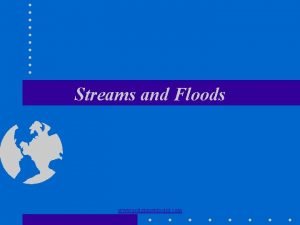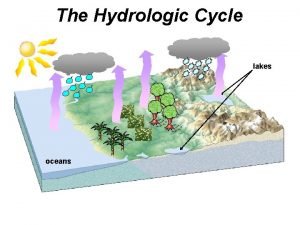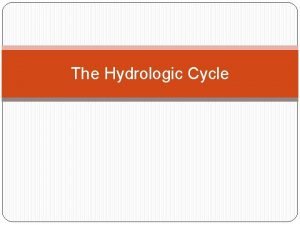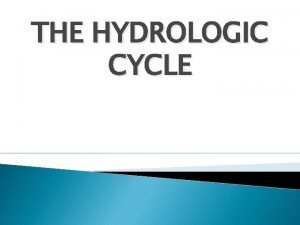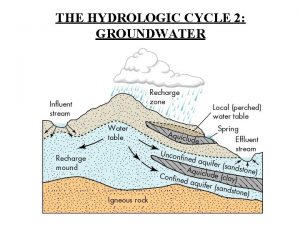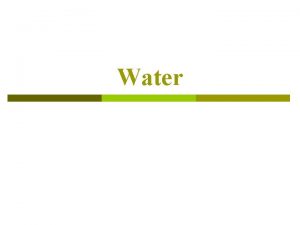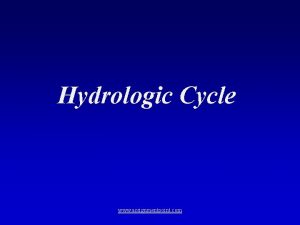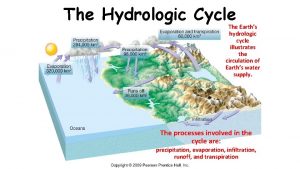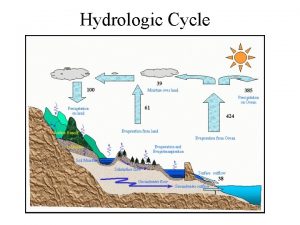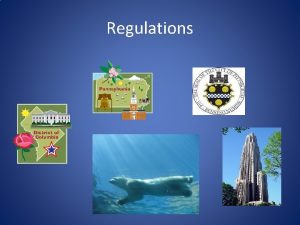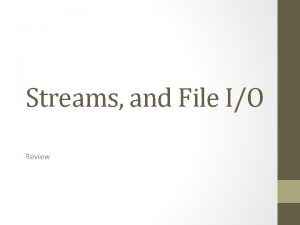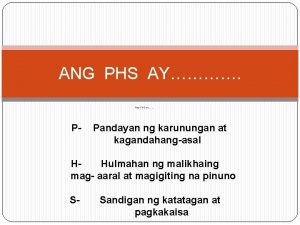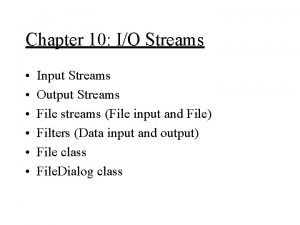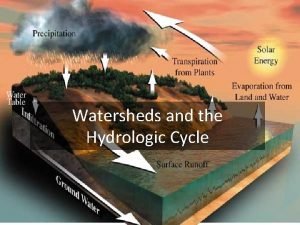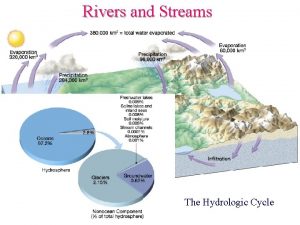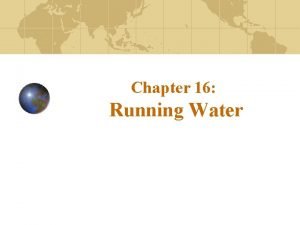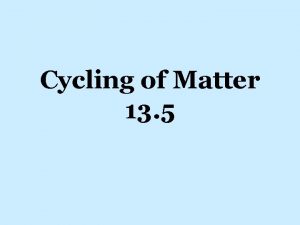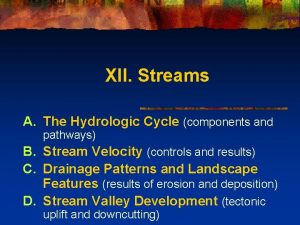PHS Geography Streams and Floods 1 Hydrologic cycle
















































- Slides: 48

PHS Geography Streams and Floods 1

Hydrologic cycle The hydrologic cycle is a summary of the circulation of Earth’s water supply Processes involved in the hydrologic cycle • Precipitation • Evaporation • Infiltration • Runoff • Transpiration 2

The Hydrologic Cycle 3

Channel flow and sheet flow Longitudinal profile of a stream Head area erosion predominant Mouth area, deposition mainly 4

Downcutting 5

Drainage Pattern Dendritic Rectangular Radial Trellis 6

Dendritic Drainage 7

Factors affecting erosion and deposition Velocity Gradient – rise over run Channel shape Channel roughness Discharge – amount of water flow per unit time, as discharge increases, load increases. 8

Velocity 9

Velocity 10

Channel shape and roughness Semicircular Flow fast Wide channel Flow slow Rough bottom Flow slow 11

Channel shape and roughness Narrow channel Flow fast Wide channel Flow slow 12

Stream Valleys Most common landform on Earth’s surface Two general types of stream valleys • Narrow valleys – V-shaped – Downcutting toward base level – Features often include rapids and waterfalls • Wide valleys – Stream is near base level – Downward erosion is less dominant – Stream energy is directed from side to side forming a floodplain 13

Stream Valleys Features of wide valleys often include: • Floodplains – Erosional: river erodes laterally – Depositional: fluctuation in conditions, base level • Meanders: sweeping bends in river channel – Cut bank: active zone of erosion – Point bar: zone of deposition – Cutoffs: shortened channel segment – Oxbow lakes: abandoned bend 14

Stream Valleys Features of narrow valleys often include: Rapids & Waterfalls Both occur where stream profile drops rapidly, • Rapids: resistive bed acts as temporary base level upstream, downcutting downstream • Waterfalls: stream makes vertical drop – Resistive rock underlain by erosive rock – Water plunges and erodes the underlying rock – Niagara Falls 15

Changes from Upstream to Downstream • Profile – Cross-sectional view of a stream – Viewed from the head (headwaters or source) to the mouth of a stream – Profile is a smooth curve – Gradient decreases downstream • Factors that increase downstream – Velocity – Discharge – Channel size • Factors that decrease downstream – Gradient – Channel roughness 16

Stream erosion Lifting loosely consolidated particles • Abrasion: particles scrape, rub, bump together and wear down • Dissolution: dissolve soluble rock by chemical reaction Stronger currents lift particles more effectively 17

Active Stream Erosion 18

Base level and graded streams • Base level: lowest point to which a stream can erode • Two general types of base level – Ultimate (sea level) – Local or temporary • Changing conditions causes readjustment of stream activities – Raising base level causes deposition – Lowering base level causes erosion 19

Adjustment of Base Level to Changing Conditions 20

Local Base Level (waterfall) 21

Sediment Transport by Streams Rolling Suspension dissolution 22

Sediment Deposition by Streams • Caused by a decrease in velocity – Competence is reduced – Sediment begins to drop out • Stream sediments – Generally well sorted – Stream sediments are known as alluvium • Channel deposits – Bars – Braided streams – Deltas 23

Sediment Deposition by Streams • Floodplain deposits – Natural levees: form parallel to the stream channel by successive floods over many years – Back swamps: marsh • Alluvial fans – Develop where a high-gradient stream leaves a narrow valley – Slopes outward in a broad arc • Deltas – Forms when a stream inters an ocean or lake – Consists of three types of beds (Foreset, Topset, Bottomset) 24

Deposition Bar 25

Braided stream 26

Braided River Resurrection River, AK 27

Erosion and Deposition Along a Meandering Stream 28

Meander Loop on the Colorado River 29

Flood plains 30

Stream Valley in Arid Region Owens Valley, CA 31

Creation of oxbow lake 32

Formation of a Delta 33

Delta southern, AK 34

Nile and Mississippi Deltas Triangle shape Bird-Foot 35

Alluvial Fan Death Valley, CA 36

Floods are the most common and most destructive geologic hazard Causes of flooding • Naturally occurring • Human-induced factors Types of floods • Regional floods • Flash floods • Ice-jam floods • Dam failure 37

Flooding Salt River, AZ 38

Floods What is a 100 -year flood? It is not a flood that occurs every 100 years Flood of a given size that has the probability of 1 in 100 of occurring in that year Better term: 1 -in-100 chance flood Urban planning based on FEMA 100 -yr flood maps 39

Flood Control Engineering efforts • Artificial levees • Flood-control Dams • Channelization Nonstructural approach through sound floodplain management • Identify high risk areas • Zoning regulations for development 40

Flood-Control Dams Store water for slow release Lowers crest of flood, spread out over time Often have other functions • agricultural irrigation water • hydroelectric power • recreation Reservoir covers previous land use: fertile farmland, historic sites, scenic valleys Sediment deposition behind dam Impediment for fish migration 41

Channelization Altering a stream channel to speed flow of water to prevent reaching flood height • Clearing channel of debris • Dredging to widen and deepen channel • Lining channel with concrete Artificial cutoff: straightening the channel • shorter stream increases gradient and velocity of water flow • larger discharge associated with flooding dispersed more quickly Army Corp of Engineers 42

Artificial Levees Earthen mounds on river banks to increase the volume capacity of river Steeper slopes than natural levees Trap sediment that otherwise would have been deposited in floodplain River bed build up often requires raising the height of levee over time Many artificial levees not built to withstand extreme flooding Levee failure numberous on Miss. (1993) 43

Erosional Floodplain 44

Incised Meanders and Stream Terraces • Incised meanders – Meanders in steep, narrow valleys – Caused by a drop in base level or uplift of the region • Stream Terraces – Remnants of a former floodplain – River has adjusted to a relative drop in base level by downcutting – Results in horizontal plane above current floodplain 45

Stream terraces 46

Incised Meanders Delores River, CO 47

Incised Meanders Colorado River, Canyonlands NP, UT 48
 Water cycle the hydrologic cycle
Water cycle the hydrologic cycle Hydrologic routing and hydraulic routing
Hydrologic routing and hydraulic routing Phs human subjects and clinical trials information
Phs human subjects and clinical trials information Disadvantages of washlands
Disadvantages of washlands Hydrologic engineering center
Hydrologic engineering center Difference between channel routing and reservoir routing
Difference between channel routing and reservoir routing Hydrologic routing
Hydrologic routing Hydrologic losses
Hydrologic losses Write the inflow as a formula
Write the inflow as a formula Hydrologic abstractions
Hydrologic abstractions Objectiveable
Objectiveable Hydrology continuity equation
Hydrology continuity equation Hydrologic engineering center
Hydrologic engineering center Lumped flow routing
Lumped flow routing River analysis system
River analysis system Hydrologic engineering center
Hydrologic engineering center Phs wrdsb
Phs wrdsb Ongruent
Ongruent Phs rameno
Phs rameno Wdfw phs
Wdfw phs Phs group wiki
Phs group wiki Mr flood's party poem
Mr flood's party poem Ladysmith floods 1994
Ladysmith floods 1994 Are floods constructive or destructive
Are floods constructive or destructive Bangladesh floods case study
Bangladesh floods case study Conclusion on flood
Conclusion on flood York floods 2000
York floods 2000 2008 floods mackay
2008 floods mackay Banbury floods 1998
Banbury floods 1998 Morpeth floods 2008
Morpeth floods 2008 Bill nye rivers and streams answers
Bill nye rivers and streams answers Fan kuan travelers by streams and mountains
Fan kuan travelers by streams and mountains Middle course of a river
Middle course of a river Gulf stream
Gulf stream Cost streams
Cost streams Oracle streams
Oracle streams Poljes
Poljes Sand dune migration
Sand dune migration Setfill
Setfill Data nugget streams as sensors answers
Data nugget streams as sensors answers 3 types of fire streams
3 types of fire streams Illustrate the proper handling of fire streams
Illustrate the proper handling of fire streams Oracle streams
Oracle streams Basic concepts in mining data streams
Basic concepts in mining data streams A framework for clustering evolving data streams
A framework for clustering evolving data streams Streams anu
Streams anu 2140705
2140705 Streams lazy evaluation
Streams lazy evaluation Oa air washer
Oa air washer



